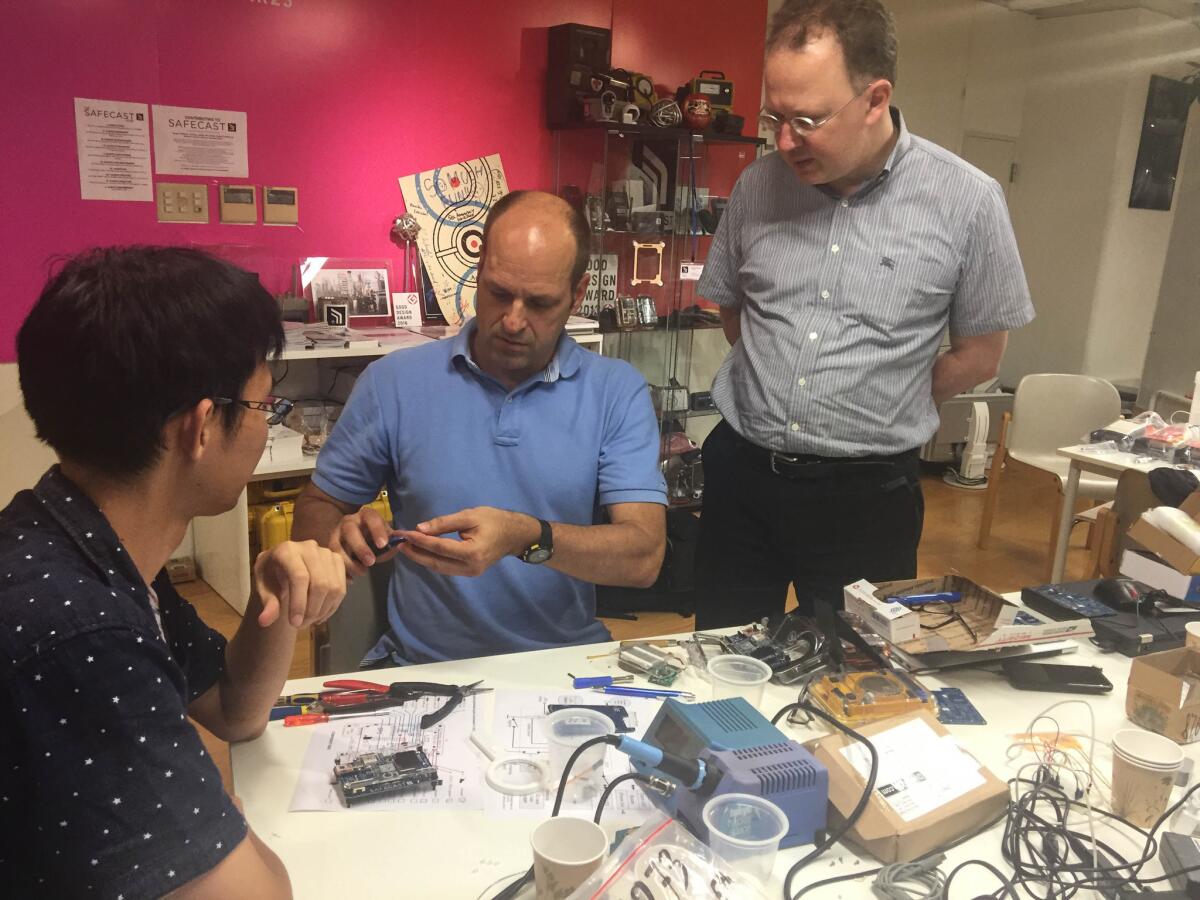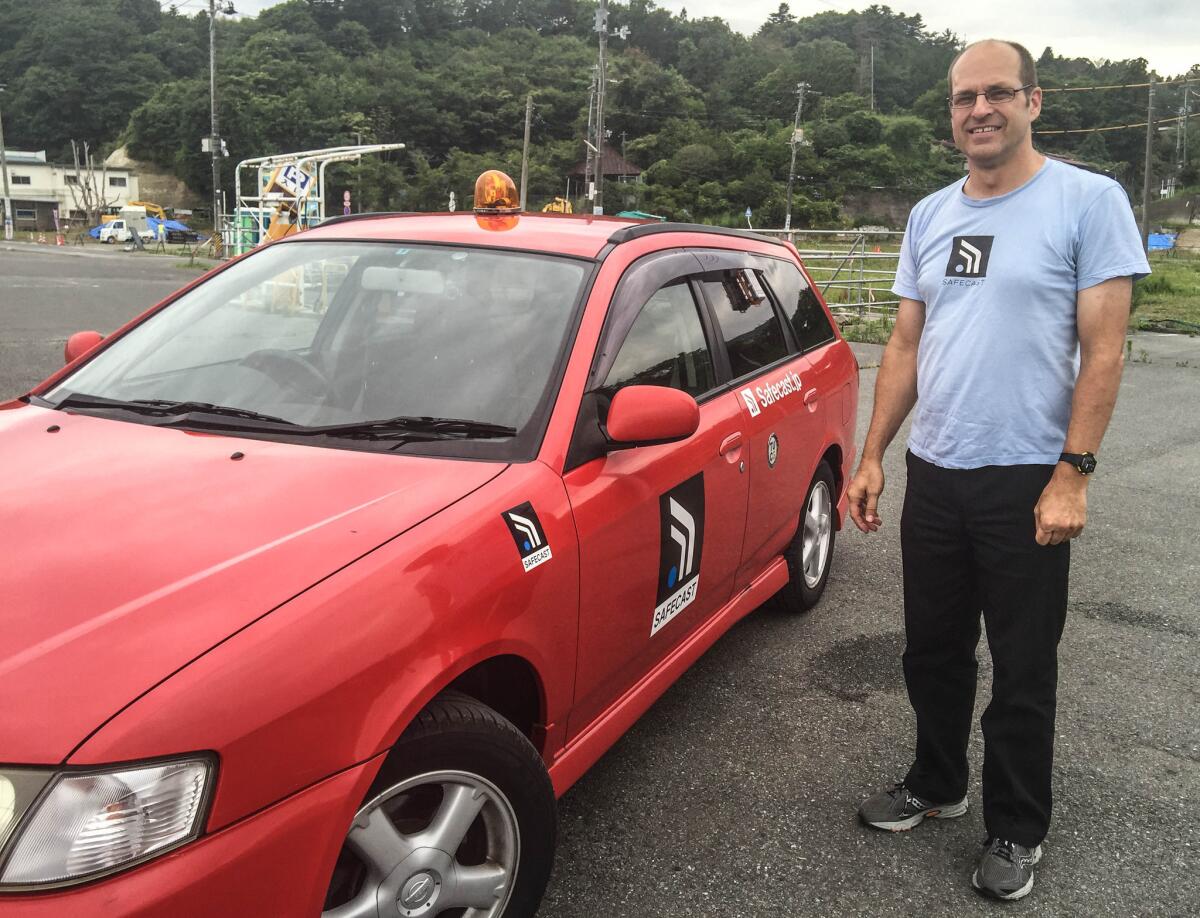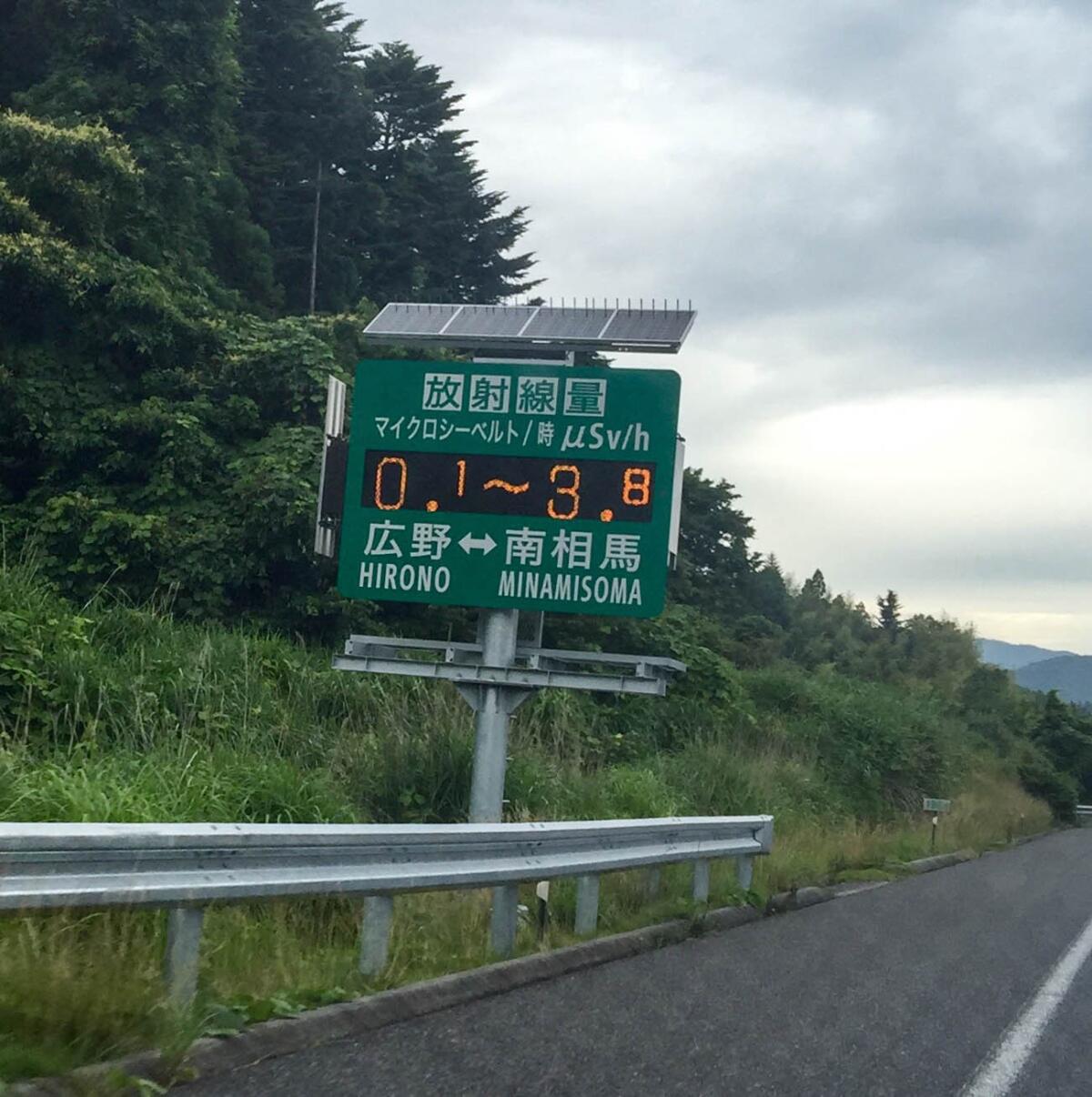Citizen science takes on Japan’s nuclear establishment

- Share via
Reporting from Tokyo — As other Tokyo office workers poured into restaurants and bars at quitting time one recent evening, Kohei Matsushita went to the eighth floor of a high-rise for an unusual after-hours activity: learning how to assemble his own Geiger counter from a kit.
Hunched over a circuit board, the 37-year-old practiced his soldering technique as Joe Moross, a former L.A. resident with a background in radiation detection, explained how to fit together about $500 worth of components – including a sensor, circuit board, digital display, GPS module, battery and case.
For the record:
9:24 p.m. June 21, 2019An earlier version and a correction of this article gave the wrong location for an eco-farm retreat in regard to the Fukushima nuclear power plant. The retreat, in Iitate, is about 20 miles northwest of the power plant.
“My family has a house near a nuclear power plant,” Matsushita said, explaining his motivation. “I want to take this there and collect data, and contribute to this pool of information.”
“This pool” is a stunning set of data – 50 million readings and counting, all logged and mapped on a website anyone can see – collected by volunteers with self-built equipment. Known as Safecast, the group was founded just days after the massive earthquake, tsunami and nuclear meltdown that shocked Japan in March 2011.
Though the immediate threat of radiation from the Fukushima Daiichi nuclear power plant has waned, interest in Safecast’s data has not. The organization, which takes no position on nuclear power, is supported by foundations, grants and individual donations.

Volunteers from Safecast teach people how to build geiger counters that are networked together to give them access to realtime data about radiation levels remaining after the 2011 Fukushima nuclear power plant melted down as a result of an earthquak
Part of the growing movement known as citizen science, the idea is to give people the knowledge and the tools to better understand their environment, and make more informed decisions based on accurate information.
Trust in both nuclear power plant operators and the government has not fully recovered since the disaster. As authorities push ahead with the contentious process of restarting dozens of nuclear reactors taken off-line in wake of the disaster, Japanese like Matsushita say a network of monitors controlled by ordinary people could serve as an early warning system in the event of another disaster.
Meanwhile, as Prime Minister Shinzo Abe’s administration continues with its extensive effort to decontaminate areas around Fukushima Daiichi and reopen evacuated towns and villages, potential returnees say they want a way to verify official numbers that indicate radiation really has dropped to safe levels.
“They want people to come back, but there’s no decontamination in the forest areas and those cover 75% of this village,” says retired engineer Nobuyoshi Ito, 72, who in 2010 opened an eco-farm retreat in Iitate, about 20 miles northwest of the nuclear power plant. Recently, he had Safecast install a radiation monitor at the retreat, which is still in a restricted zone. “We have to check ourselves.”
++
Joe Moross straps a GPS-enabled Geiger counter the size of a small brick to the back window of his red station wagon on the outskirts of Tokyo and begins a 16-hour day driving north through the most contaminated areas around the Fukushima nuclear plant. In the last five years, he calculates he’s driven 90,000 miles gathering data for Safecast.

Through a Bluetooth connection, he can monitor the Geiger counter’s readings on his cellphone as he goes. But he also keeps a mental log of more qualitative signs of the region’s transformation.
“That 7-Eleven reopened in 2014,” he notes as he nears the town of Tomioka. “That Family Mart came back in 2015.” In the town of Naraha, he gasps. “That’s the first rice growing in the fields here in five years!”
Along the way, he passes several dozen fixed-point radiation monitors installed by the government along the roadsides. Their solar-powered, digital displays provide readouts in microsieverts per hour (μSv/hr); today’s show relatively low readings from 0.1 to 3.8 between the towns of Hirono and Minamisoma. That is less than what one would be exposed to on a long flight, although that exposure lasts only as long as the flight.

Moross’ much more granular, mobile data, recorded every five seconds and uploaded to the Web the next day, generally matches the government signs, though when passing near the Fukushima plant, Moross’ counter produces readings above 4 μSv/hr. (Not long after the disaster, Safecast found readings higher than 30 in the region).
In the town of Iwaki, Moross drops in on Brett Waterman, a 51-year-old Australian who’s been teaching English in the area for 11 years and was having some technical issues with a Safecast monitor.
“Like most people, I knew nothing about radiation” when the disaster hit, says Waterman, who acquired an early Safecast Geiger counter through Kickstarter and has since upgraded to more sophisticated models as the group has refined its designs. Waterman says the data indicate Iwaki is now safe, but it’s important to keep generating frequent readings to provide a reference of what’s “normal” in case circumstances change.
Safecast holds regular sessions for adults to teach them to assemble their own devices and is planning a kids’ workshop as well. Plans and directions for building the devices are also available online for free. Organizers say that people who build their own monitors are much more motivated to use them.
“If they just buy one, they may use it once, throw it in a drawer and never upload any data,” says Moross. “If they make it themselves, they’re more invested.”
++
Safecast’s tiny Tokyo office feels like a combination tech start-up, old-school shop class, and comedy club for middle-aged expats. As Moross inspects Matsushita’s soldering progress, English teacher Jonathan Wilder, 59, is busy gathering switches, resistors, batteries, and sensors and parceling them out into plastic bags that will become kits for Safecast’s current workhorse Geiger counter, known as the bGeigie Nano.
Moross and Wilder trade jokes as Azby Brown, 60, an expert on traditional Japanese architecture, sits at another table typing up news for the group’s blog; he has just led Safecast’s efforts to publish its first scientific paper, in the Journal of Radiological Protection. Pieter Franken, a Dutch expatriate and chief technology officer for a large securities firm, looks over some materials for the group’s upcoming kids’ workshop.
“Safecast is an interesting social experiment, in a fairly anarchistic kind of way,” says Franken, one of the group’s founders. “It taps into trends including maker-spaces, the Internet of things and even artists. We attract people who want to break out of the traditional way of solving problems.”
Safecast grew out of an email conversation among Franken, L.A.-based tech entrepreneur Sean Bonner and MIT Media Lab director Joichi “Joi” Ito immediately after the March 11, 2011, disaster. As the Fukushima crisis unfolded, Safecast’s effort to produce and distribute Geiger counters and collect data snowballed, drawing in more expertise and volunteers. The group has successively iterated smaller and smaller Geiger counters with more functionality for data collection.
In the last five years, Safecast volunteers have taken radiation readings all over the world, from Brisbane, Australia, to Santa Monica. The group is also working on monitoring air quality in Los Angeles and elsewhere; recently, volunteers took methane readings around Porter Ranch during the gas leak there. Now, Safecast is trying to figure out how to depict that kind of data meaningfully online.
Moross says the potential applications for citizen-based environmental monitoring are vast, pointing to incidents such as the recent scandal over the lead-tainted water supply in Flint, Mich., as an example of where deeper community-based scientific knowledge could have improved debate and policymaking.
“Flint and Fukushima have parallels,” says Moross. “Democracy should start from facts, and we need to give citizens facts to understand what’s happening.”
Safecast has taken heat from both pro- and anti-nuclear activists, Brown says. “But if people spend some time with us, they find we are valuable.” Even Japan’s postal service has cooperated with Safecast, putting its monitors on carriers’ motorbikes in some towns and gathering data.
Safecast’s goal now is, essentially, “base-lining the world,” says Franken, crowdsourcing environmental data from every corner of the Earth.
“We should start with measuring our environments,” he says. “Then we can talk about things like global warming and air pollution; from there, activism can start. Once you know, for example, that your street is polluted, you can start to make a change. That’s where we can make a difference.”
Follow me on Twitter @JulieMakLAT.
More to Read
Sign up for Essential California
The most important California stories and recommendations in your inbox every morning.
You may occasionally receive promotional content from the Los Angeles Times.











